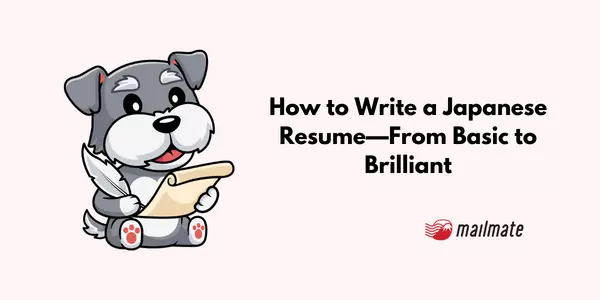How to Write a Japanese Resume—From Basic to Brilliant

Are you job-hunting in Japan and struggling to write a Japanese-style resume?
No worries, we’ve got you covered! This article will walk you through the process of writing an impressive Japanese-style resume.
What is a Japanese-style resume?
Japanese resumes 履歴書 = rirekisho consist of your educational background, work experience, and personal information such as name, date of birth, and contact information.
Writing an impressive Japanese-style resume will make you more attractive to the companies you're applying to.
What type of resume structure do Japanese use?
A Japanese-style resume consists of five main sections:
1. Basic personal information
The first section of the resume is where you fill in all basic information, including (1) the resume submission date, (2) full name (氏名), (3) nationality (国籍), (4) date of birth 生年月日 - age(年齢, (5) gender (性別), (6) current address (現住所), (7) telephone number (電話), (8) email address (メールアドレス –), (9) contact (連絡先), (10) photo.

Source: Gtalent.
2. Academic/work history
The next section of the Japanese resume is for academic and work history. This is where you can list all relevant academic background (学歴), work history (職歴), past employment history, etc.

Source: Gtalent.
3. Licenses or qualifications
The license or qualifications (免許・資格) section gives you room the impress recruiters with your Japanese skills and any other relevant skills.

Source: Gtalent.
4. Special skills, self-promotion, commuting time (特技・自己PRなど, 通勤時間, 扶養家族)
This section gives you room to promote yourself and accumulate special skills. Also, you can fill in other personal information such as commuting time and dependents.

Source: Gtalent.
5. Space for personal requests (本人希望記入欄)
This last section is where you can express more specific requests regarding work description, work location, or salary.

Source: Gtalent.
Now that you've got a basic idea of what a Japanese-style resume looks like, let's discover some cool writing tips to appeal to your recruiters!
Five tips to help land you a job with a Japanese-style resume
Tip 1. Ensure your resume is reader-friendly
Make sure your handwriting is as tidy as possible if you're writing your resume by hand. Throughout the document, use Japanese honorific terms like desu or –masu and Arabic numbers (1, 2, 3).
Tip 2. Create a good first impression
Since you'll have a photo attached to the resume's first page, it'll likely be the first item that catches the recruiters' attention.
Hence, you should include a bright and tidy photo with your resume. A photoshoot in a studio is preferable to one taken at a photo booth if at all possible. If you take the photos at home, make sure to use a good photo editor to correct the lighting, backgrounds and general image quality if needed. Make sure you look presentable and smile so you don't come across as tense.
It's important to remember to have your photo taken three months before the submission date. If the recruiters require an electronic copy of your photo, you can save the photo in an electronic version for future reference.
Tip 3. Make yourself reachable
It’s crucial to have your contact information up to date. For example, you can choose to be contacted via your cellphone or landline, whichever is easier for the companies to reach you. You do not want to miss a call for an early interview or even a job offer.
Tip 4. Show off your skills
You may think it is hard to show off your technical skills in a strictly structured resume, but this is not entirely true!
To impress employers, you can list all of your language certificates and educational qualifications in the license and certifications section. For instance, some of the certificates below would catch their attention:
Tip 5. Express who you are
The section for personal statements (本人希望) and reasons for applying (志望動機) is where you shine!
Use this area to briefly describe why you're applying for the job and what you intend to gain. Don't forget to explain why you're interested in the role, what talents and experiences you can bring to the table, and how you can help the organization in different ways.
How to write a powerful personal statement on a resume
After a great deal of research and interviews with successful people, we've combined a shortlist of how to engage the companies in knowing more about you.
Idea 1. Show how you can integrate your passion into the job.
In our article on 3 Lessons from Teruo Kise: Former Chairman of TOTO, we've learned that you can either love what you'll do or do what you love, depending on how you integrate the work with your interest.
Former TOTO chairman, Kise, grew to love talking to people during a stint working in the sales department. Even though he didn't initially enjoy the role, he gradually found joy in his work. As he loved reading, he realized that the characters in his books were not so different from the new people he met every day. People were not similar, and by meeting and conversing with them, he understood them a little better, similar to how the characters are revealed through the pages.
Idea 2. Highlight your skills and knowledge that are relevant.
We admire Amélie Geeraert from the interview on her experience as Kokoro Media’s Editor because she's accumulated a great amount of work experience before working as an editor.
She started with being interested in Japanese manga and video games, leading her to explore Japanese culture and participating in an exchange program. Then she expanded her working skills in different fields, from language education, fiction writing, and Japanese services. Her passions and experiences brought her to where she is today, doing what she loves and excels in.
Watch this video if you're interested in more tips to nail your interview!
Frequently asked questions
What is a Japanese resume (rirekisho)?
A Japanese resume is called rirekisho (履歴書) in Japanese. It is a document that consists of your educational background, work experience, and personal information such as name, date of birth, and contact information.
How is a Japanese resume different from a Western Resume?
A Japanese resume requires a resume photo. One's work history must be written in chronological order, and personal statements or objectives are usually not included.
Where can I find a Japanese Resume template?
You can find a free Japanese resume template from various online resources, including job search websites.
Do I need to write my Japanese Resume in Japanese?
A Japanese Resume is typically written in Japanese. However, this will depend on the company you are applying to.
In closing
We wish you good luck in getting your dream job with an outstanding resume!
Please share your thoughts on your job-hunting experience on our blog, Twitter, or Linkedin page! We’d love to hear from you!
Spending too long figuring out your Japanese mail?
Virtual mail + translation services start at 3800 per month. 30-day money-back guarantee.

